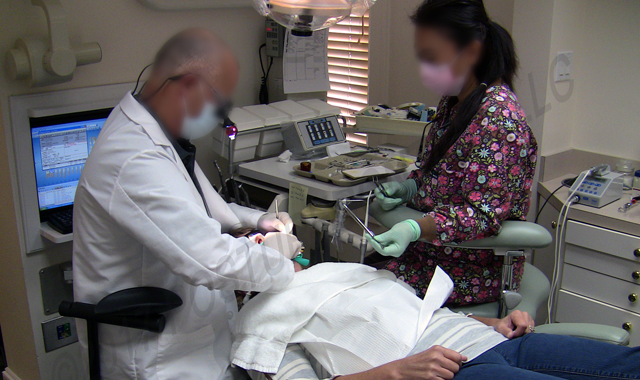Delivery systems – Is yours delivering pain?
Understanding the differences between delivery systems can help you select the right one for your team.

When one thinks of ergonomics, one often imagines the equipment we wear, hold or sit upon. The equipment that surrounds us can have just as great of an impact as the equipment that is in constant contact with our bodies. Delivery systems impact the operator’s body mechanics and can result in movement dysfunction and shoulder joint or lower-back problems.
Each delivery system has its pros and cons and can profoundly impact the operator’s musculoskeletal health and productivity - either positively or negatively. Some are better suited to four-handed operatories, some to hygienist operatories, some work best for taller operators and others facilitate higher productivity. Understanding these differences can help you select the right system for your team.
Trending article: Are right angles ... wrong?
Fig. 1

Rear-delivery systems accommodate all clinical instruments behind the patient, which frees up space for other larger pieces of equipment in the operatory. It is the least expensive option and keeps the equipment out of view of the patient, which may decrease anxiety. Functionally, rear delivery works quite well when true four-handed dentistry is practiced. With true four-handed dentistry, the assistant is fully utilized, makes all transfers to the doctor and changes burs on the handpieces, so the dentist is not forced to twist to retrieve his or her own handpieces. (Fig. 1)
The rear delivery system is the poorest method of delivery in two-hand function (such as the hygienist operatory) as it encourages operators to extensively reach, lean or twist their torsos to retrieve instruments from behind the patient’s head, which can contribute to low-back pain. When operators must work with rear delivery in a two-handed function, they should try to retrieve instruments with the closest (non-dominant) hand to avoid repeated twisting or reaching across the body and then transfer the instrument to the dominant hand.
Fig. 2

Some rear-delivery systems limit access from 11 to 12 o’clock positions, which frequently offer the best ergonomic access during a procedure. In this case, the chair should be rotated to enable access in the 12 o’clock position.
Side-delivery systems require less trunk-twisting than rear delivery for the doctor to retrieve instruments. (Fig. 2) However, since the assistant cannot reach the instruments, productivity may often be compromised. The dentist must remember to squarely face the system when changing burs, rather than sustaining a twisted posture. Side delivery works especially well in a two-handed operatory.
One problem I see with dentists who use side delivery is the tendency to “lock” themselves into one working position relative to the patient. This tends to overwork and fatigue certain areas of the body and can lead to pain. The best practice with any delivery system is to change positions as frequently as possible, depending on the tooth surface being treated. Ensuring the side-delivery system is re-positioned when the dentist changes clock positions helps prevent repeated leaning or extended reaching to one side to retrieve instruments.
Correct height of the side-delivery system is paramount to preventing shoulder pain and injury. The instruments and handpieces should be no higher than elbow level.
More from the author: The 4 ergonomic 'must-haves' in a patient chair
Fig. 3

Over-the-patient delivery systems allow free movement from the 8 o’clock to 12 o’clock positions around the patient’s head. The unit is on an arm that extends over the chest of the patient, so handpieces and other instruments are within easy reach for both dentist and assistant, minimizing excessive leaning, reaching and shift of vision. (Fig. 3)
However, this system is highly visible, which some doctors feel may increase anxiety. It may also be bumped by the patient, which makes it especially undesirable for most pedo offices.
For operators with shorter torsos, the system may require repeated upward reaching at the shoulder, an ergonomic risk factor for shoulder pain. This is easily resolved with a saddle-style stool.
Also, for the assistant’s health, don’t position the system too far down the patient’s stomach, since this will cause your assistant to have to twist to retrieve instruments.
Fig. 4

Over-the-head delivery systems have become recognized as a unique solution to dental delivery. (Fig. 4) Combining many of the benefits of over-the-patient and rear-delivery systems, over-the-head systems allow the operator the ability to practice from the 7 o’clock to 1 o’clock positions. Supplies are in an ideal position for assistant access, while handpieces are more accessible than rear-delivery layouts, reducing the ergonomic challenges when in two-hand function. Additionally, over-the-head layouts, when properly configured, convert from right- to left-hand function rapidly. Designed by Dr. David Ahearn, these units are manufactured by Ergonomic Products, Inc.
When a dentist purchases the “wrong” ergonomic equipment, they only have two choices: live with it and suffer the associated musculoskeletal discomfort or injuries or buy new equipment and try to sell the old. Neither is an attractive option. It makes more sense to do the research and invest in equipment that will benefit your health and extend your career right from the start.
If you enjoyed this article, Dr. Valachi offers much more evidence-based dental ergonomic education in her monthly newsletter. Sign up at www.posturedontics.com.